Electronegativities - Study guides, Class notes & Summaries
Looking for the best study guides, study notes and summaries about Electronegativities? On this page you'll find 220 study documents about Electronegativities.
Page 4 out of 220 results
Sort by
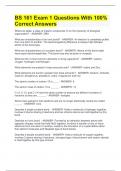
-
BS 161 Exam 1 Questions With 100% Correct Answers
- Exam (elaborations) • 14 pages • 2024
- Available in package deal
-
- $10.59
- + learn more
BS 161 Exam 1 Questions With 100% Correct Answers Where do lipids, a class of organic compounds, fit on the hierarchy of biological organization? - ANSWER- DNA What are characteristics of an ionic bond? - ANSWER- An electron is completely pulled from one atom to another. The electronegativity difference is always high between atoms of this bond type. What are characteristics of a covalent bond? - ANSWER- Atoms of this bond might have equal electronegativities. This bond may also be pola...
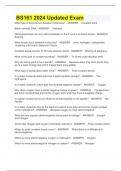
-
BS161 2024 Updated Exam
- Exam (elaborations) • 31 pages • 2024
-
- $9.99
- + learn more
BS161 2024 Updated Exam What type of bond occurs between molecules? - ANSWER Covalent bond Blank unwinds DNA - ANSWER Helicase DNA polymerase can only add nucleotides to the 3' end of an blank strand - ANSWER Existing What forces occur between molecules? - ANSWER Ionic, hydrogen, hydrophobic clustering and london dispersion forces Covalent bonds involve To fill outer electron shells - ANSWER Sharing of electrons. What is the goal of covalent bonding? - ANSW...
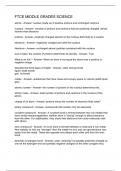
-
FTCE MIDDLE GRADES SCIENCE
- Other • 7 pages • 2023
- Available in package deal
-
- $10.99
- + learn more
atoms - Answer- nucleus made up of positive protons and uncharged neutrons nucleus - Answer- consists of protons and neutrons that are positively charged, dense, heavier than electrons protons - Answer- positively charged element in the nucleus that binds to a neutron electrons - Answer- negatively charged and orbit the nucleus Neutrons - Answer- uncharged atomic particles contained with the nucleus true or false: the number of protons determines its identity - Answer- True Wha...
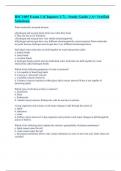
-
BSC1005 Exam 1 (Chapters 1-7) - Study Guide || A+ Verified Solutions.
- Exam (elaborations) • 8 pages • 2024
- Available in package deal
-
- $10.99
- + learn more
Water molecules are polar because a.Hydrogen and oxygen atoms form ions when they bond b.They are key to ice formation c.Hydrogen and oxygen have very similar electronegativity d.Hydrogen and oxygen have very different electronegativity correct answers Water molecules are polar because hydrogen and oxygen have very different electronegativities. Individual water molecules are held together by weak interactions called a. double bonds b. ionic bonds c. covalent bonds d. hydrogen bonds...
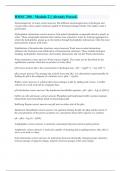
-
BMSC 200 - Module 2 || Already Passed.
- Exam (elaborations) • 8 pages • 2024
- Available in package deal
-
- $10.79
- + learn more
Electronegativity of water correct answers The different electronegativities of hydrogen and oxygen make water a polar molecule capable of forming hydrogen bonds. This makes water a good solute. Hydrophobic interactions correct answers Non-polar hydrophobic compounds dissolve poorly in water. These compounds minimize their surface area exposed to water by forming aggregates in which the hydrophobic groups go to the interior through hydrophobic interactions. Only the more polar portions intera...
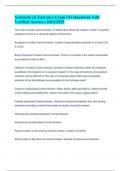
-
Semmelweis Entrance Exam (N) Questions with Verified Answers 2024/2025
- Exam (elaborations) • 10 pages • 2024
- Available in package deal
-
- $8.48
- + learn more
Semmelweis Entrance Exam (N) Questions with Verified Answers 2024/2025 The mole concept Correct Answer: A method that allows the relative number of reactant particles involved in a chemical reaction to be known Avogadro's number Correct Answer: number of representative particles in a mole, 6.02 X 10^23 Basic structures of atoms Correct Answer: There is a nucleus in the center surrounded by an electron cloud or field Quantum numbers Correct Answer: Quantum numbers describe values of...
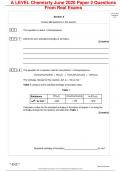
-
A LEVEL Chemisrty June 2020 Paper 2 Questions From Real Exams
- Exam (elaborations) • 31 pages • 2023
-
- $13.49
- + learn more
A LEVEL Chemisrty June 2020 Paper 2 Questions From Real Exams 1 2 Section A Answer all questions in this section. Do not write outside the box This question is about 1-chloropropane. . Define the term standard enthalpy of formation. [2 marks] . The equation for a reaction used to manufacture 1-chloropropane is 3CH3CH2CH2OH(l) + PCl3(l) 3CH3CH2CH2Cl(l) + H3PO3(s) The enthalpy change for this reaction, ΔH, is –114 kJ mol–1 Table 1 contains some standard enthalpy of formati...

-
Anatomy & Physiology Ch. 2 (Chemistry of Life) with complete verified solutions.
- Exam (elaborations) • 6 pages • 2024
- Available in package deal
-
- $15.49
- + learn more
Matter Anything that has mass and occupies space Atom Smallest unit of matter Protons Found in Nucleus, positively charged Electrons Found outside Nucleus, negatively charged Neutrons Found in Nucleus, neutral charge Atomic Number Number of protons an atom has Human body is made up of what 4 elements? Hydrogen, Carbon, Oxygen, Nitrogen Suspension Mixture containing large, unevenly distributed particles Colloid Mixture with small, evenly distribute...
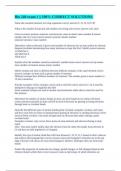
-
Bio 240 exam 1 || 100% CORRECT SOLUTIONS.
- Exam (elaborations) • 8 pages • 2024
- Available in package deal
-
- $11.39
- + learn more
Name the essential elements in living organisms correct answers C, N, H, O (S+P) What is the smallest living unit and smallest non living unit correct answers cell, atom Given an atom's protons, neutrons, and electrons, state an atom's mass number & atomic number and vice versa correct answers protons=atomic number neutrons+protons= mass number Determine valence electrons if given total number of electrons for an atom and/or its electron diagram (includes determining how many ele...
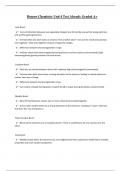
-
Honors Chemistry Unit 4 Test Already Graded A+
- Exam (elaborations) • 6 pages • 2024
- Available in package deal
-
- $9.49
- + learn more
Honors Chemistry Unit 4 Test Already Graded A+ Ionic Bond: ️ Force of attraction between two oppositely charged ions formed by one particle losing electrons and another gaining electrons. ️ Formed when one atom takes an electron from another atom—ions are the result (one positive, one negative)—they stick together because of opposite charges. ️ Difference between electronegativities is high. ️ Involves metals (low electronegativity) losing electrons to form cati...

How did he do that? By selling his study resources on Stuvia. Try it yourself! Discover all about earning on Stuvia


